Cultural Safety in Healthcare: The Media's Impact in Australia
VerifiedAdded on 2023/06/05
|10
|2938
|353
Essay
AI Summary
This essay examines the role of Australian media (print, internet, broadcasting) in shaping the healthcare system, particularly regarding cultural safety within a multicultural society. It highlights the media's function in informing the public and government, influencing health behaviors, and promoting democracy. The essay references the Australian Broadcasting Corporation's role in providing diverse and educational programming, and the media's involvement in political discourse and public awareness campaigns, such as tobacco control. It further analyzes two media articles: one discussing the government's commitment to improving Aboriginal and Torres Strait Islander health through the 'Closing the Gap' platform, and another cautioning against the unprescribed use of aspirin for healthy individuals over 70. The analysis explores both the positive and potential negative influences of these articles on public perceptions and health-seeking behaviors. The essay concludes by emphasizing the media's power to shape attitudes, expectations, and ultimately, health outcomes within the Australian community.
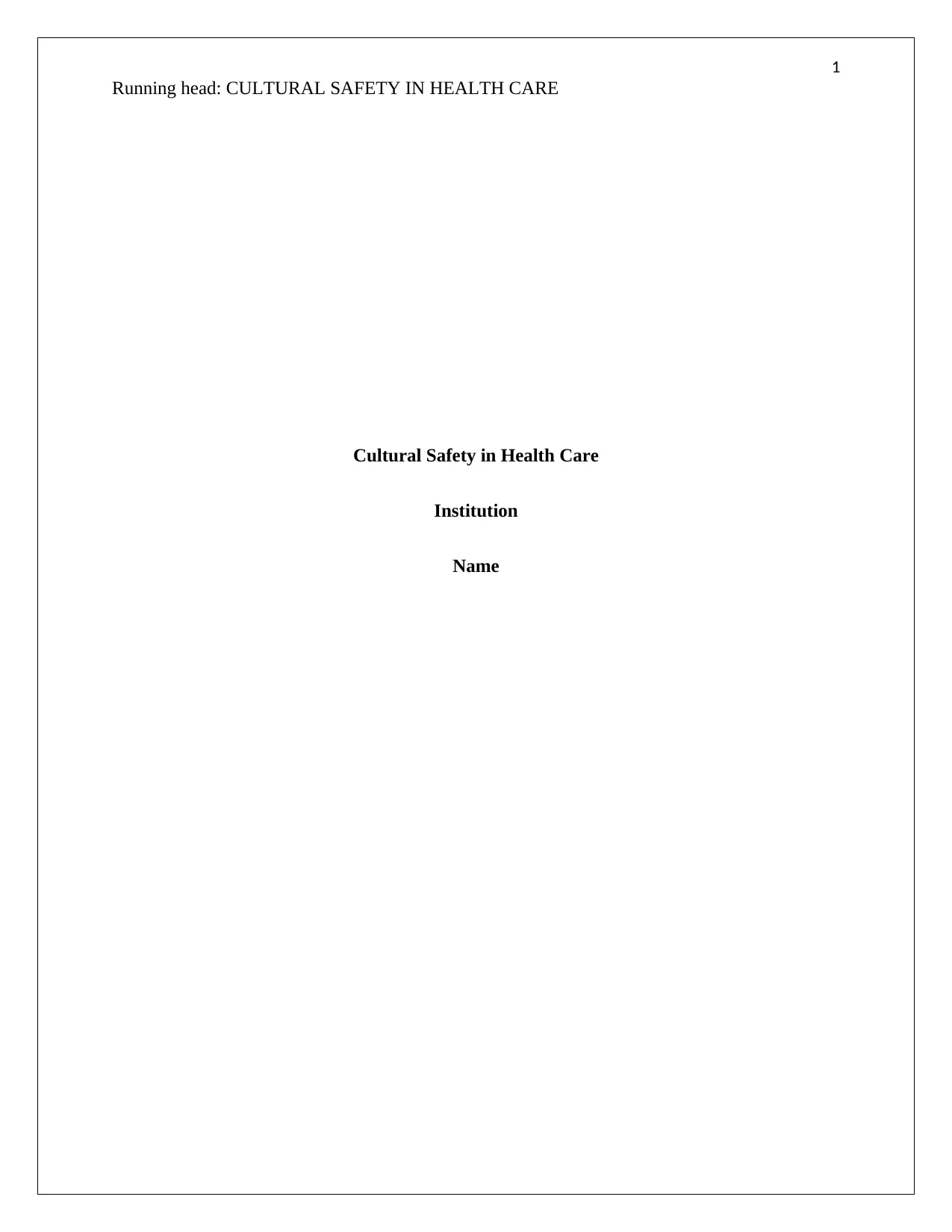
1
Running head: CULTURAL SAFETY IN HEALTH CARE
Cultural Safety in Health Care
Institution
Name
Running head: CULTURAL SAFETY IN HEALTH CARE
Cultural Safety in Health Care
Institution
Name
Paraphrase This Document
Need a fresh take? Get an instant paraphrase of this document with our AI Paraphraser
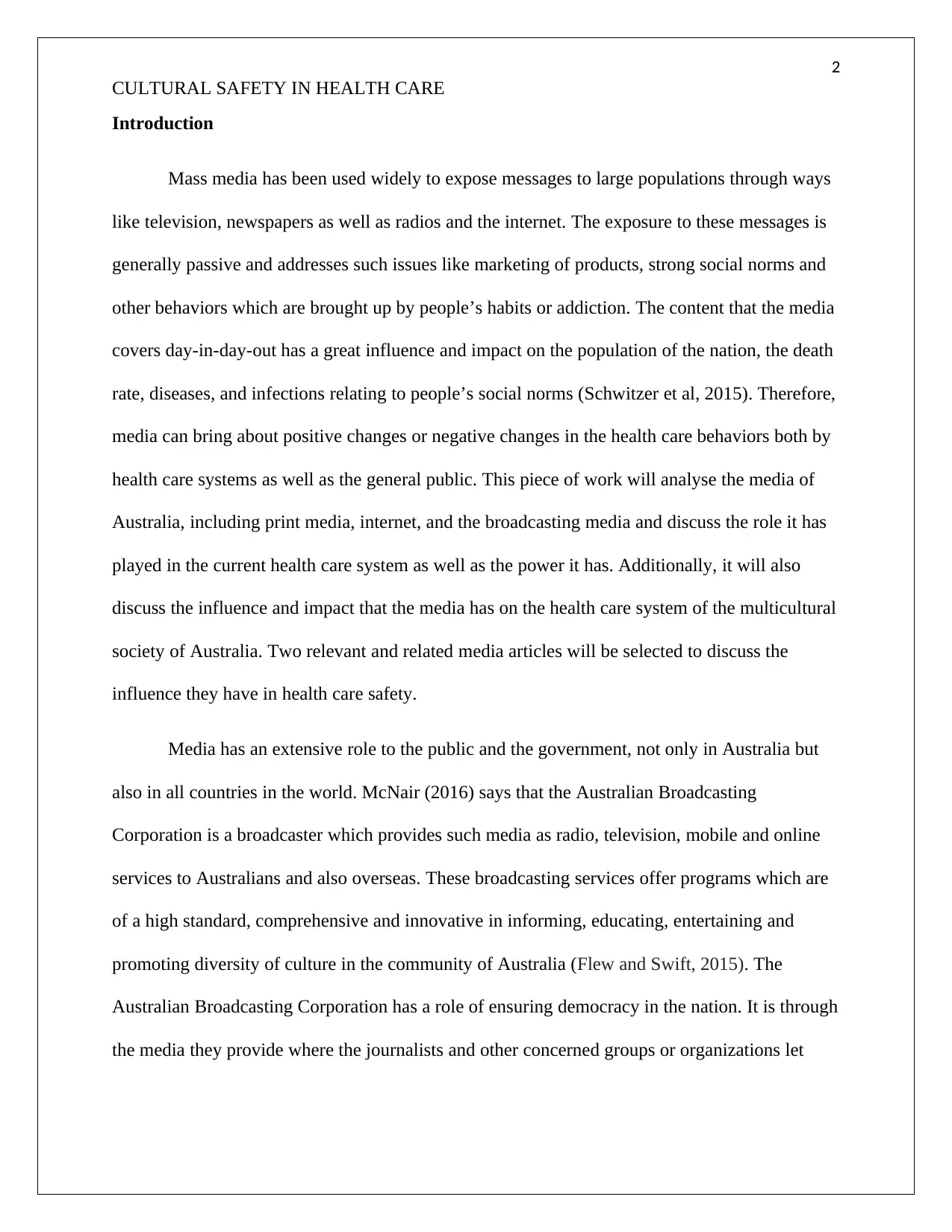
2
CULTURAL SAFETY IN HEALTH CARE
Introduction
Mass media has been used widely to expose messages to large populations through ways
like television, newspapers as well as radios and the internet. The exposure to these messages is
generally passive and addresses such issues like marketing of products, strong social norms and
other behaviors which are brought up by people’s habits or addiction. The content that the media
covers day-in-day-out has a great influence and impact on the population of the nation, the death
rate, diseases, and infections relating to people’s social norms (Schwitzer et al, 2015). Therefore,
media can bring about positive changes or negative changes in the health care behaviors both by
health care systems as well as the general public. This piece of work will analyse the media of
Australia, including print media, internet, and the broadcasting media and discuss the role it has
played in the current health care system as well as the power it has. Additionally, it will also
discuss the influence and impact that the media has on the health care system of the multicultural
society of Australia. Two relevant and related media articles will be selected to discuss the
influence they have in health care safety.
Media has an extensive role to the public and the government, not only in Australia but
also in all countries in the world. McNair (2016) says that the Australian Broadcasting
Corporation is a broadcaster which provides such media as radio, television, mobile and online
services to Australians and also overseas. These broadcasting services offer programs which are
of a high standard, comprehensive and innovative in informing, educating, entertaining and
promoting diversity of culture in the community of Australia (Flew and Swift, 2015). The
Australian Broadcasting Corporation has a role of ensuring democracy in the nation. It is through
the media they provide where the journalists and other concerned groups or organizations let
CULTURAL SAFETY IN HEALTH CARE
Introduction
Mass media has been used widely to expose messages to large populations through ways
like television, newspapers as well as radios and the internet. The exposure to these messages is
generally passive and addresses such issues like marketing of products, strong social norms and
other behaviors which are brought up by people’s habits or addiction. The content that the media
covers day-in-day-out has a great influence and impact on the population of the nation, the death
rate, diseases, and infections relating to people’s social norms (Schwitzer et al, 2015). Therefore,
media can bring about positive changes or negative changes in the health care behaviors both by
health care systems as well as the general public. This piece of work will analyse the media of
Australia, including print media, internet, and the broadcasting media and discuss the role it has
played in the current health care system as well as the power it has. Additionally, it will also
discuss the influence and impact that the media has on the health care system of the multicultural
society of Australia. Two relevant and related media articles will be selected to discuss the
influence they have in health care safety.
Media has an extensive role to the public and the government, not only in Australia but
also in all countries in the world. McNair (2016) says that the Australian Broadcasting
Corporation is a broadcaster which provides such media as radio, television, mobile and online
services to Australians and also overseas. These broadcasting services offer programs which are
of a high standard, comprehensive and innovative in informing, educating, entertaining and
promoting diversity of culture in the community of Australia (Flew and Swift, 2015). The
Australian Broadcasting Corporation has a role of ensuring democracy in the nation. It is through
the media they provide where the journalists and other concerned groups or organizations let
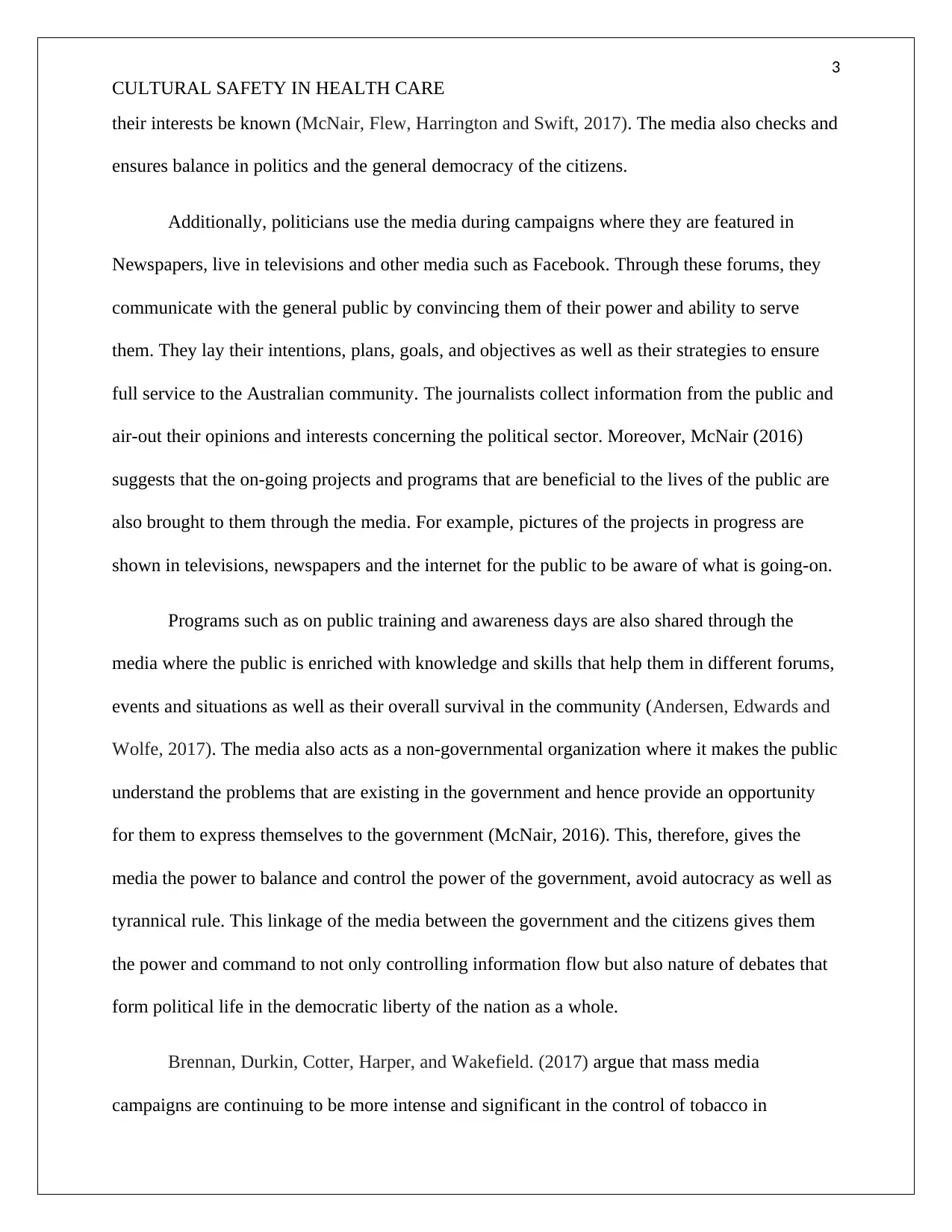
3
CULTURAL SAFETY IN HEALTH CARE
their interests be known (McNair, Flew, Harrington and Swift, 2017). The media also checks and
ensures balance in politics and the general democracy of the citizens.
Additionally, politicians use the media during campaigns where they are featured in
Newspapers, live in televisions and other media such as Facebook. Through these forums, they
communicate with the general public by convincing them of their power and ability to serve
them. They lay their intentions, plans, goals, and objectives as well as their strategies to ensure
full service to the Australian community. The journalists collect information from the public and
air-out their opinions and interests concerning the political sector. Moreover, McNair (2016)
suggests that the on-going projects and programs that are beneficial to the lives of the public are
also brought to them through the media. For example, pictures of the projects in progress are
shown in televisions, newspapers and the internet for the public to be aware of what is going-on.
Programs such as on public training and awareness days are also shared through the
media where the public is enriched with knowledge and skills that help them in different forums,
events and situations as well as their overall survival in the community (Andersen, Edwards and
Wolfe, 2017). The media also acts as a non-governmental organization where it makes the public
understand the problems that are existing in the government and hence provide an opportunity
for them to express themselves to the government (McNair, 2016). This, therefore, gives the
media the power to balance and control the power of the government, avoid autocracy as well as
tyrannical rule. This linkage of the media between the government and the citizens gives them
the power and command to not only controlling information flow but also nature of debates that
form political life in the democratic liberty of the nation as a whole.
Brennan, Durkin, Cotter, Harper, and Wakefield. (2017) argue that mass media
campaigns are continuing to be more intense and significant in the control of tobacco in
CULTURAL SAFETY IN HEALTH CARE
their interests be known (McNair, Flew, Harrington and Swift, 2017). The media also checks and
ensures balance in politics and the general democracy of the citizens.
Additionally, politicians use the media during campaigns where they are featured in
Newspapers, live in televisions and other media such as Facebook. Through these forums, they
communicate with the general public by convincing them of their power and ability to serve
them. They lay their intentions, plans, goals, and objectives as well as their strategies to ensure
full service to the Australian community. The journalists collect information from the public and
air-out their opinions and interests concerning the political sector. Moreover, McNair (2016)
suggests that the on-going projects and programs that are beneficial to the lives of the public are
also brought to them through the media. For example, pictures of the projects in progress are
shown in televisions, newspapers and the internet for the public to be aware of what is going-on.
Programs such as on public training and awareness days are also shared through the
media where the public is enriched with knowledge and skills that help them in different forums,
events and situations as well as their overall survival in the community (Andersen, Edwards and
Wolfe, 2017). The media also acts as a non-governmental organization where it makes the public
understand the problems that are existing in the government and hence provide an opportunity
for them to express themselves to the government (McNair, 2016). This, therefore, gives the
media the power to balance and control the power of the government, avoid autocracy as well as
tyrannical rule. This linkage of the media between the government and the citizens gives them
the power and command to not only controlling information flow but also nature of debates that
form political life in the democratic liberty of the nation as a whole.
Brennan, Durkin, Cotter, Harper, and Wakefield. (2017) argue that mass media
campaigns are continuing to be more intense and significant in the control of tobacco in
⊘ This is a preview!⊘
Do you want full access?
Subscribe today to unlock all pages.

Trusted by 1+ million students worldwide
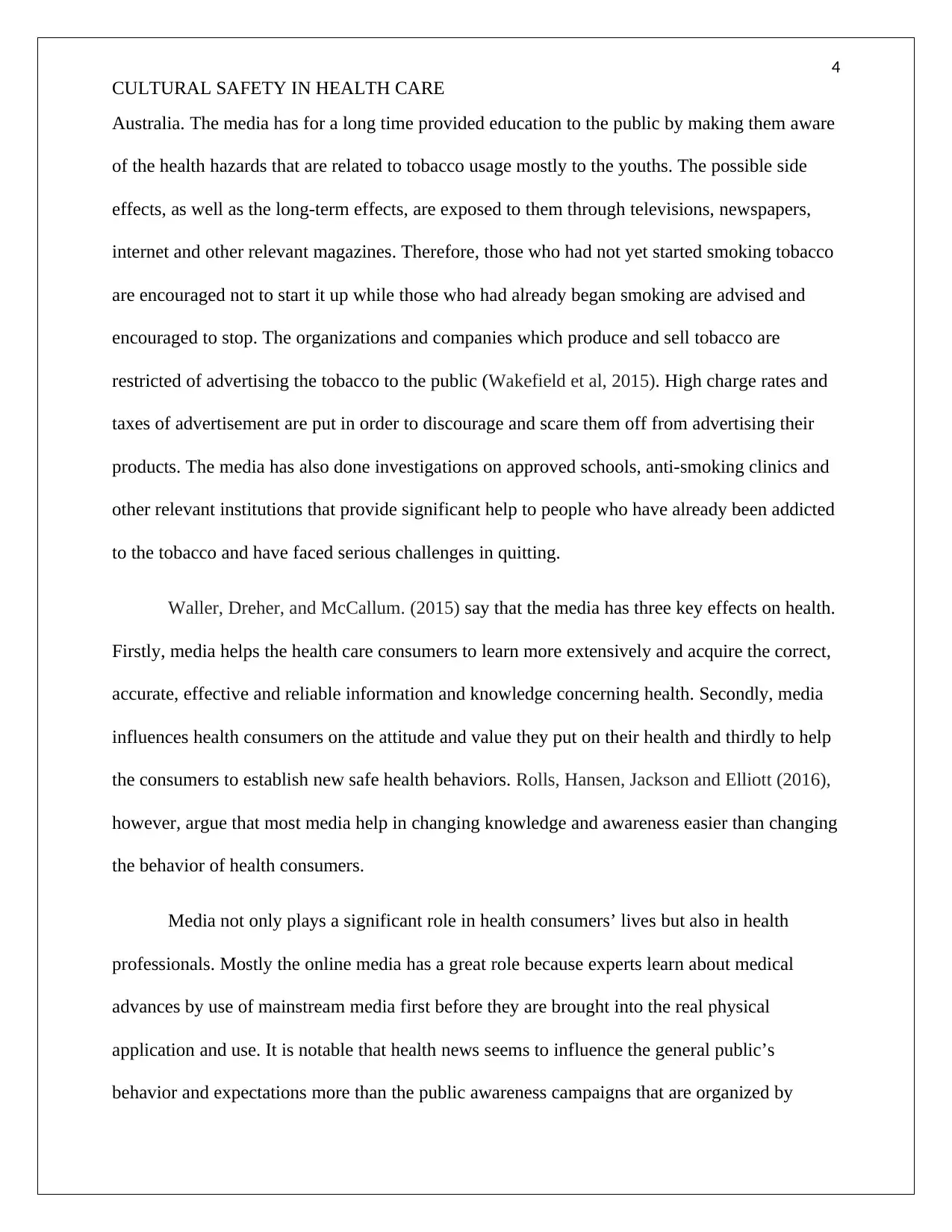
4
CULTURAL SAFETY IN HEALTH CARE
Australia. The media has for a long time provided education to the public by making them aware
of the health hazards that are related to tobacco usage mostly to the youths. The possible side
effects, as well as the long-term effects, are exposed to them through televisions, newspapers,
internet and other relevant magazines. Therefore, those who had not yet started smoking tobacco
are encouraged not to start it up while those who had already began smoking are advised and
encouraged to stop. The organizations and companies which produce and sell tobacco are
restricted of advertising the tobacco to the public (Wakefield et al, 2015). High charge rates and
taxes of advertisement are put in order to discourage and scare them off from advertising their
products. The media has also done investigations on approved schools, anti-smoking clinics and
other relevant institutions that provide significant help to people who have already been addicted
to the tobacco and have faced serious challenges in quitting.
Waller, Dreher, and McCallum. (2015) say that the media has three key effects on health.
Firstly, media helps the health care consumers to learn more extensively and acquire the correct,
accurate, effective and reliable information and knowledge concerning health. Secondly, media
influences health consumers on the attitude and value they put on their health and thirdly to help
the consumers to establish new safe health behaviors. Rolls, Hansen, Jackson and Elliott (2016),
however, argue that most media help in changing knowledge and awareness easier than changing
the behavior of health consumers.
Media not only plays a significant role in health consumers’ lives but also in health
professionals. Mostly the online media has a great role because experts learn about medical
advances by use of mainstream media first before they are brought into the real physical
application and use. It is notable that health news seems to influence the general public’s
behavior and expectations more than the public awareness campaigns that are organized by
CULTURAL SAFETY IN HEALTH CARE
Australia. The media has for a long time provided education to the public by making them aware
of the health hazards that are related to tobacco usage mostly to the youths. The possible side
effects, as well as the long-term effects, are exposed to them through televisions, newspapers,
internet and other relevant magazines. Therefore, those who had not yet started smoking tobacco
are encouraged not to start it up while those who had already began smoking are advised and
encouraged to stop. The organizations and companies which produce and sell tobacco are
restricted of advertising the tobacco to the public (Wakefield et al, 2015). High charge rates and
taxes of advertisement are put in order to discourage and scare them off from advertising their
products. The media has also done investigations on approved schools, anti-smoking clinics and
other relevant institutions that provide significant help to people who have already been addicted
to the tobacco and have faced serious challenges in quitting.
Waller, Dreher, and McCallum. (2015) say that the media has three key effects on health.
Firstly, media helps the health care consumers to learn more extensively and acquire the correct,
accurate, effective and reliable information and knowledge concerning health. Secondly, media
influences health consumers on the attitude and value they put on their health and thirdly to help
the consumers to establish new safe health behaviors. Rolls, Hansen, Jackson and Elliott (2016),
however, argue that most media help in changing knowledge and awareness easier than changing
the behavior of health consumers.
Media not only plays a significant role in health consumers’ lives but also in health
professionals. Mostly the online media has a great role because experts learn about medical
advances by use of mainstream media first before they are brought into the real physical
application and use. It is notable that health news seems to influence the general public’s
behavior and expectations more than the public awareness campaigns that are organized by
Paraphrase This Document
Need a fresh take? Get an instant paraphrase of this document with our AI Paraphraser
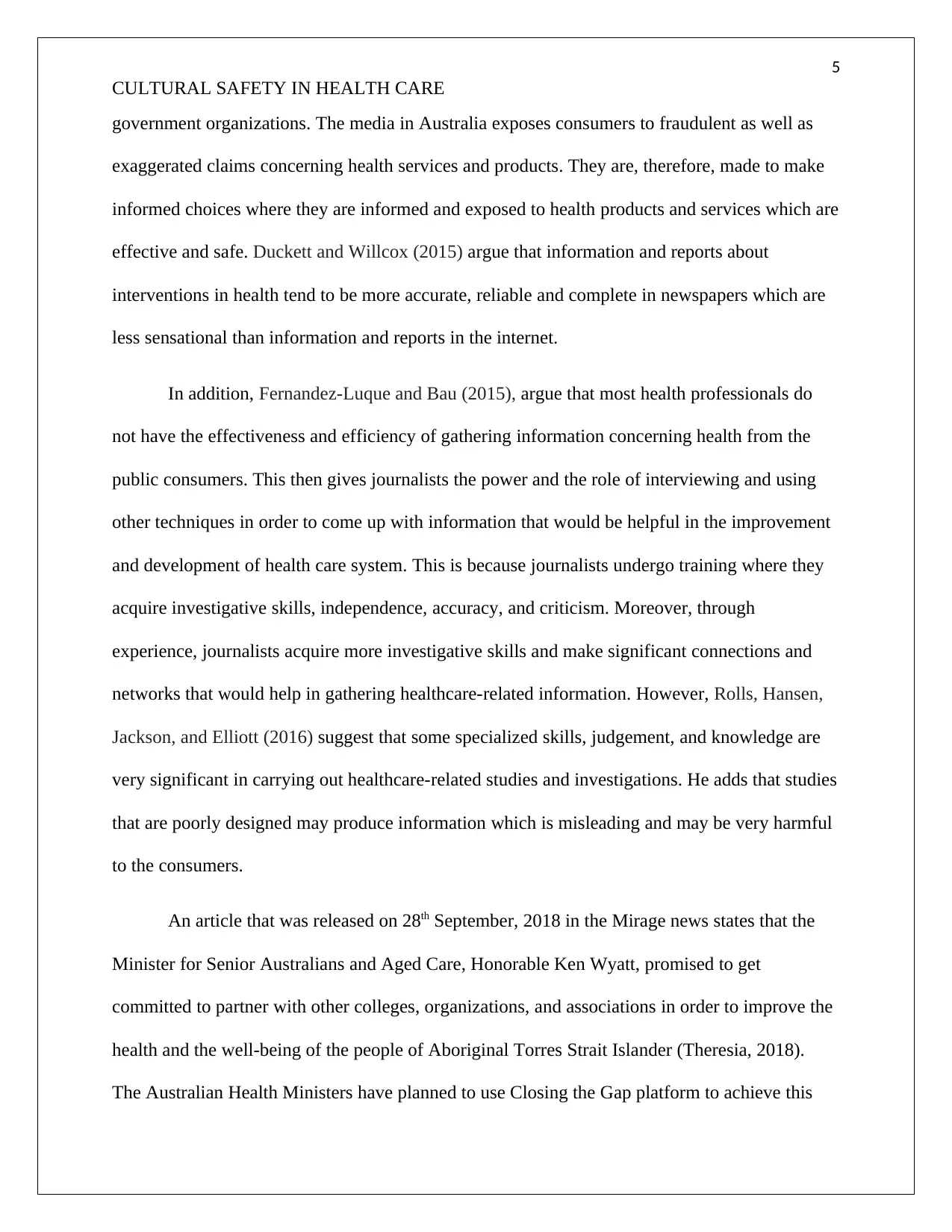
5
CULTURAL SAFETY IN HEALTH CARE
government organizations. The media in Australia exposes consumers to fraudulent as well as
exaggerated claims concerning health services and products. They are, therefore, made to make
informed choices where they are informed and exposed to health products and services which are
effective and safe. Duckett and Willcox (2015) argue that information and reports about
interventions in health tend to be more accurate, reliable and complete in newspapers which are
less sensational than information and reports in the internet.
In addition, Fernandez-Luque and Bau (2015), argue that most health professionals do
not have the effectiveness and efficiency of gathering information concerning health from the
public consumers. This then gives journalists the power and the role of interviewing and using
other techniques in order to come up with information that would be helpful in the improvement
and development of health care system. This is because journalists undergo training where they
acquire investigative skills, independence, accuracy, and criticism. Moreover, through
experience, journalists acquire more investigative skills and make significant connections and
networks that would help in gathering healthcare-related information. However, Rolls, Hansen,
Jackson, and Elliott (2016) suggest that some specialized skills, judgement, and knowledge are
very significant in carrying out healthcare-related studies and investigations. He adds that studies
that are poorly designed may produce information which is misleading and may be very harmful
to the consumers.
An article that was released on 28th September, 2018 in the Mirage news states that the
Minister for Senior Australians and Aged Care, Honorable Ken Wyatt, promised to get
committed to partner with other colleges, organizations, and associations in order to improve the
health and the well-being of the people of Aboriginal Torres Strait Islander (Theresia, 2018).
The Australian Health Ministers have planned to use Closing the Gap platform to achieve this
CULTURAL SAFETY IN HEALTH CARE
government organizations. The media in Australia exposes consumers to fraudulent as well as
exaggerated claims concerning health services and products. They are, therefore, made to make
informed choices where they are informed and exposed to health products and services which are
effective and safe. Duckett and Willcox (2015) argue that information and reports about
interventions in health tend to be more accurate, reliable and complete in newspapers which are
less sensational than information and reports in the internet.
In addition, Fernandez-Luque and Bau (2015), argue that most health professionals do
not have the effectiveness and efficiency of gathering information concerning health from the
public consumers. This then gives journalists the power and the role of interviewing and using
other techniques in order to come up with information that would be helpful in the improvement
and development of health care system. This is because journalists undergo training where they
acquire investigative skills, independence, accuracy, and criticism. Moreover, through
experience, journalists acquire more investigative skills and make significant connections and
networks that would help in gathering healthcare-related information. However, Rolls, Hansen,
Jackson, and Elliott (2016) suggest that some specialized skills, judgement, and knowledge are
very significant in carrying out healthcare-related studies and investigations. He adds that studies
that are poorly designed may produce information which is misleading and may be very harmful
to the consumers.
An article that was released on 28th September, 2018 in the Mirage news states that the
Minister for Senior Australians and Aged Care, Honorable Ken Wyatt, promised to get
committed to partner with other colleges, organizations, and associations in order to improve the
health and the well-being of the people of Aboriginal Torres Strait Islander (Theresia, 2018).
The Australian Health Ministers have planned to use Closing the Gap platform to achieve this
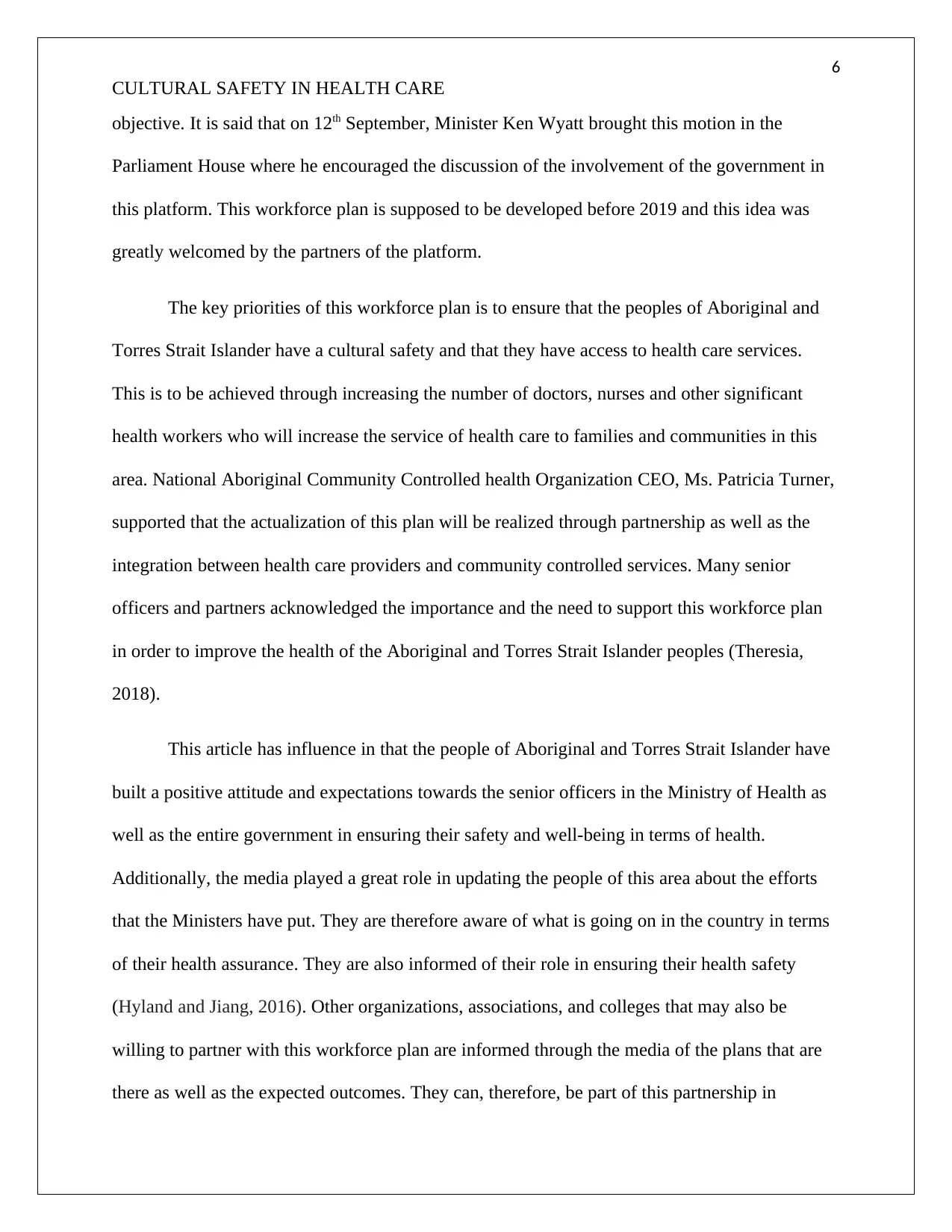
6
CULTURAL SAFETY IN HEALTH CARE
objective. It is said that on 12th September, Minister Ken Wyatt brought this motion in the
Parliament House where he encouraged the discussion of the involvement of the government in
this platform. This workforce plan is supposed to be developed before 2019 and this idea was
greatly welcomed by the partners of the platform.
The key priorities of this workforce plan is to ensure that the peoples of Aboriginal and
Torres Strait Islander have a cultural safety and that they have access to health care services.
This is to be achieved through increasing the number of doctors, nurses and other significant
health workers who will increase the service of health care to families and communities in this
area. National Aboriginal Community Controlled health Organization CEO, Ms. Patricia Turner,
supported that the actualization of this plan will be realized through partnership as well as the
integration between health care providers and community controlled services. Many senior
officers and partners acknowledged the importance and the need to support this workforce plan
in order to improve the health of the Aboriginal and Torres Strait Islander peoples (Theresia,
2018).
This article has influence in that the people of Aboriginal and Torres Strait Islander have
built a positive attitude and expectations towards the senior officers in the Ministry of Health as
well as the entire government in ensuring their safety and well-being in terms of health.
Additionally, the media played a great role in updating the people of this area about the efforts
that the Ministers have put. They are therefore aware of what is going on in the country in terms
of their health assurance. They are also informed of their role in ensuring their health safety
(Hyland and Jiang, 2016). Other organizations, associations, and colleges that may also be
willing to partner with this workforce plan are informed through the media of the plans that are
there as well as the expected outcomes. They can, therefore, be part of this partnership in
CULTURAL SAFETY IN HEALTH CARE
objective. It is said that on 12th September, Minister Ken Wyatt brought this motion in the
Parliament House where he encouraged the discussion of the involvement of the government in
this platform. This workforce plan is supposed to be developed before 2019 and this idea was
greatly welcomed by the partners of the platform.
The key priorities of this workforce plan is to ensure that the peoples of Aboriginal and
Torres Strait Islander have a cultural safety and that they have access to health care services.
This is to be achieved through increasing the number of doctors, nurses and other significant
health workers who will increase the service of health care to families and communities in this
area. National Aboriginal Community Controlled health Organization CEO, Ms. Patricia Turner,
supported that the actualization of this plan will be realized through partnership as well as the
integration between health care providers and community controlled services. Many senior
officers and partners acknowledged the importance and the need to support this workforce plan
in order to improve the health of the Aboriginal and Torres Strait Islander peoples (Theresia,
2018).
This article has influence in that the people of Aboriginal and Torres Strait Islander have
built a positive attitude and expectations towards the senior officers in the Ministry of Health as
well as the entire government in ensuring their safety and well-being in terms of health.
Additionally, the media played a great role in updating the people of this area about the efforts
that the Ministers have put. They are therefore aware of what is going on in the country in terms
of their health assurance. They are also informed of their role in ensuring their health safety
(Hyland and Jiang, 2016). Other organizations, associations, and colleges that may also be
willing to partner with this workforce plan are informed through the media of the plans that are
there as well as the expected outcomes. They can, therefore, be part of this partnership in
⊘ This is a preview!⊘
Do you want full access?
Subscribe today to unlock all pages.

Trusted by 1+ million students worldwide
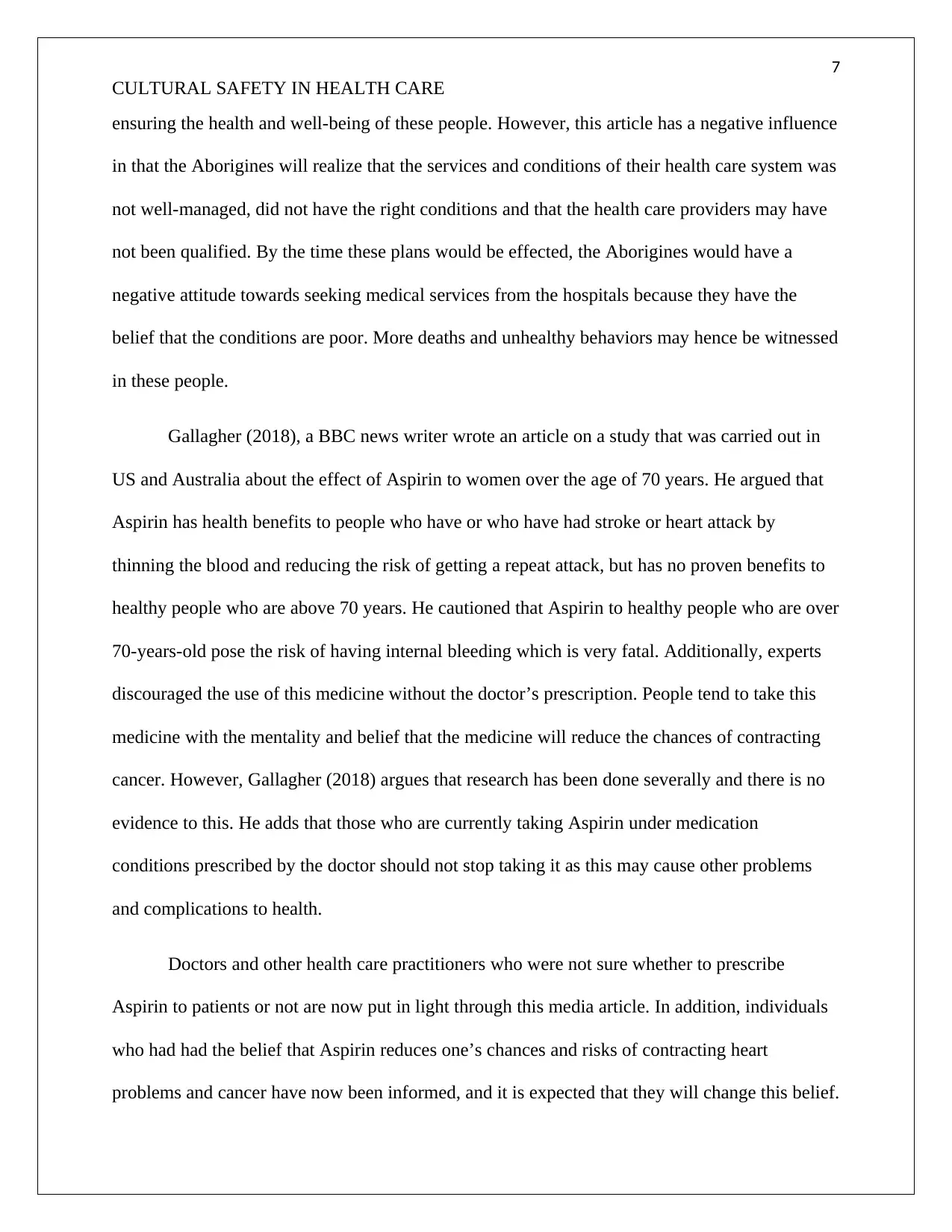
7
CULTURAL SAFETY IN HEALTH CARE
ensuring the health and well-being of these people. However, this article has a negative influence
in that the Aborigines will realize that the services and conditions of their health care system was
not well-managed, did not have the right conditions and that the health care providers may have
not been qualified. By the time these plans would be effected, the Aborigines would have a
negative attitude towards seeking medical services from the hospitals because they have the
belief that the conditions are poor. More deaths and unhealthy behaviors may hence be witnessed
in these people.
Gallagher (2018), a BBC news writer wrote an article on a study that was carried out in
US and Australia about the effect of Aspirin to women over the age of 70 years. He argued that
Aspirin has health benefits to people who have or who have had stroke or heart attack by
thinning the blood and reducing the risk of getting a repeat attack, but has no proven benefits to
healthy people who are above 70 years. He cautioned that Aspirin to healthy people who are over
70-years-old pose the risk of having internal bleeding which is very fatal. Additionally, experts
discouraged the use of this medicine without the doctor’s prescription. People tend to take this
medicine with the mentality and belief that the medicine will reduce the chances of contracting
cancer. However, Gallagher (2018) argues that research has been done severally and there is no
evidence to this. He adds that those who are currently taking Aspirin under medication
conditions prescribed by the doctor should not stop taking it as this may cause other problems
and complications to health.
Doctors and other health care practitioners who were not sure whether to prescribe
Aspirin to patients or not are now put in light through this media article. In addition, individuals
who had had the belief that Aspirin reduces one’s chances and risks of contracting heart
problems and cancer have now been informed, and it is expected that they will change this belief.
CULTURAL SAFETY IN HEALTH CARE
ensuring the health and well-being of these people. However, this article has a negative influence
in that the Aborigines will realize that the services and conditions of their health care system was
not well-managed, did not have the right conditions and that the health care providers may have
not been qualified. By the time these plans would be effected, the Aborigines would have a
negative attitude towards seeking medical services from the hospitals because they have the
belief that the conditions are poor. More deaths and unhealthy behaviors may hence be witnessed
in these people.
Gallagher (2018), a BBC news writer wrote an article on a study that was carried out in
US and Australia about the effect of Aspirin to women over the age of 70 years. He argued that
Aspirin has health benefits to people who have or who have had stroke or heart attack by
thinning the blood and reducing the risk of getting a repeat attack, but has no proven benefits to
healthy people who are above 70 years. He cautioned that Aspirin to healthy people who are over
70-years-old pose the risk of having internal bleeding which is very fatal. Additionally, experts
discouraged the use of this medicine without the doctor’s prescription. People tend to take this
medicine with the mentality and belief that the medicine will reduce the chances of contracting
cancer. However, Gallagher (2018) argues that research has been done severally and there is no
evidence to this. He adds that those who are currently taking Aspirin under medication
conditions prescribed by the doctor should not stop taking it as this may cause other problems
and complications to health.
Doctors and other health care practitioners who were not sure whether to prescribe
Aspirin to patients or not are now put in light through this media article. In addition, individuals
who had had the belief that Aspirin reduces one’s chances and risks of contracting heart
problems and cancer have now been informed, and it is expected that they will change this belief.
Paraphrase This Document
Need a fresh take? Get an instant paraphrase of this document with our AI Paraphraser
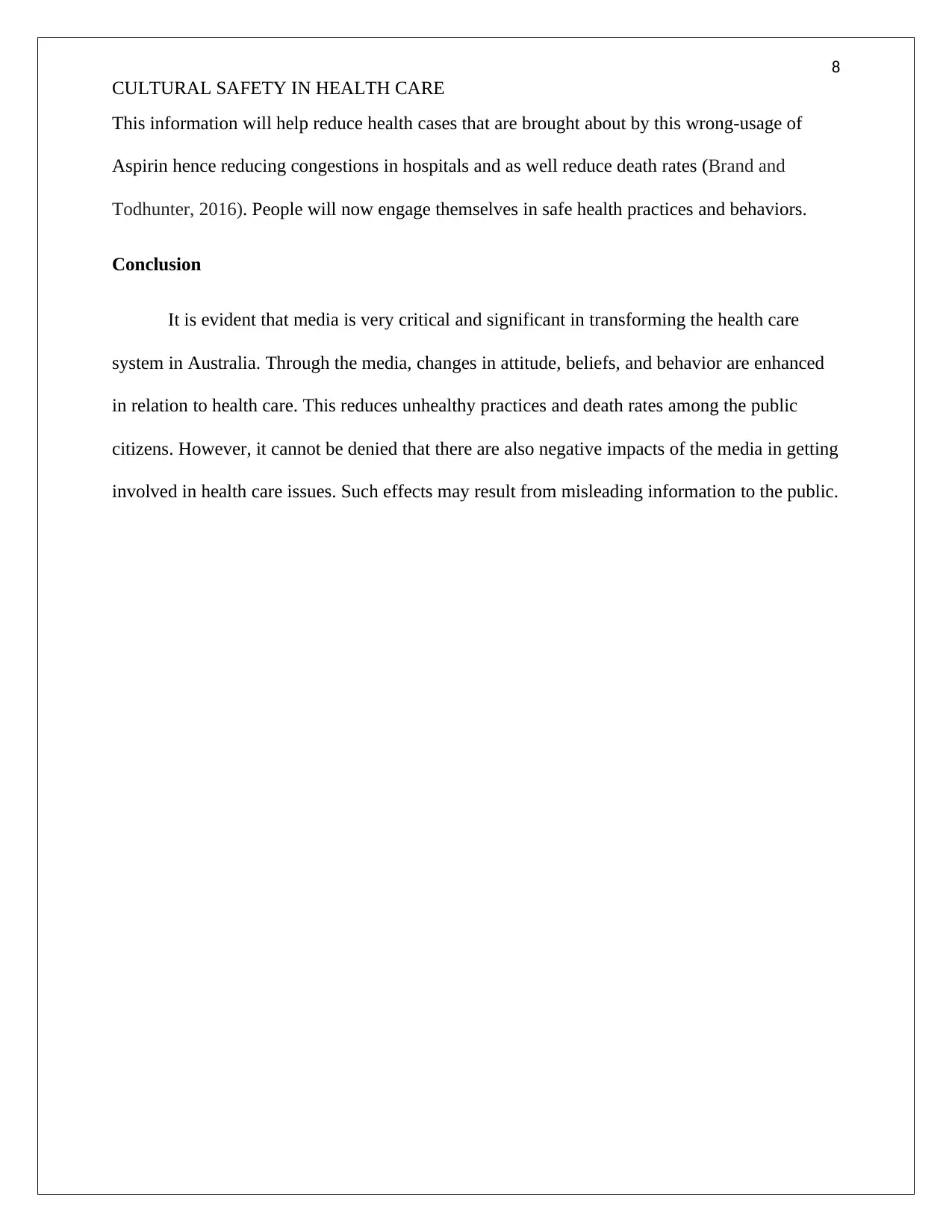
8
CULTURAL SAFETY IN HEALTH CARE
This information will help reduce health cases that are brought about by this wrong-usage of
Aspirin hence reducing congestions in hospitals and as well reduce death rates (Brand and
Todhunter, 2016). People will now engage themselves in safe health practices and behaviors.
Conclusion
It is evident that media is very critical and significant in transforming the health care
system in Australia. Through the media, changes in attitude, beliefs, and behavior are enhanced
in relation to health care. This reduces unhealthy practices and death rates among the public
citizens. However, it cannot be denied that there are also negative impacts of the media in getting
involved in health care issues. Such effects may result from misleading information to the public.
CULTURAL SAFETY IN HEALTH CARE
This information will help reduce health cases that are brought about by this wrong-usage of
Aspirin hence reducing congestions in hospitals and as well reduce death rates (Brand and
Todhunter, 2016). People will now engage themselves in safe health practices and behaviors.
Conclusion
It is evident that media is very critical and significant in transforming the health care
system in Australia. Through the media, changes in attitude, beliefs, and behavior are enhanced
in relation to health care. This reduces unhealthy practices and death rates among the public
citizens. However, it cannot be denied that there are also negative impacts of the media in getting
involved in health care issues. Such effects may result from misleading information to the public.
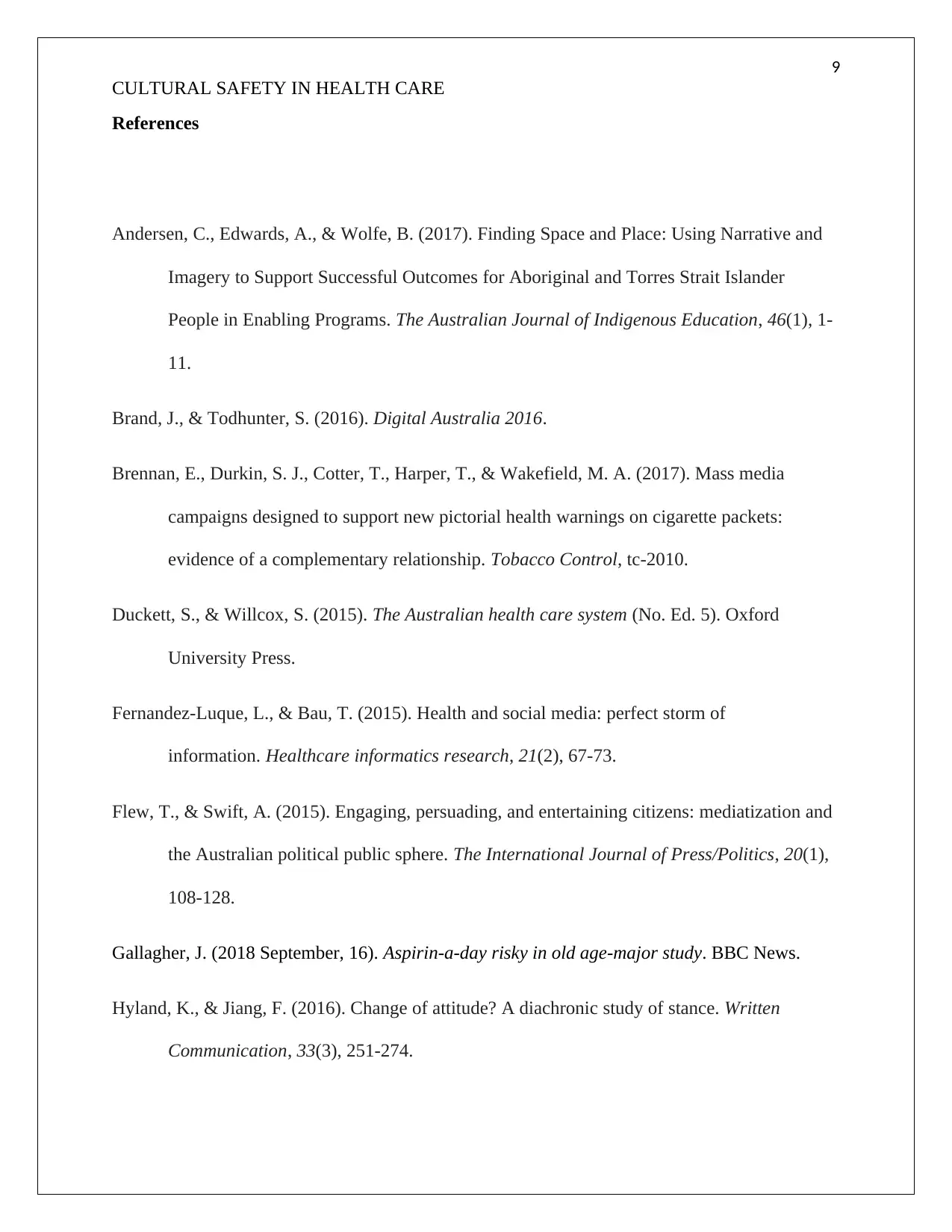
9
CULTURAL SAFETY IN HEALTH CARE
References
Andersen, C., Edwards, A., & Wolfe, B. (2017). Finding Space and Place: Using Narrative and
Imagery to Support Successful Outcomes for Aboriginal and Torres Strait Islander
People in Enabling Programs. The Australian Journal of Indigenous Education, 46(1), 1-
11.
Brand, J., & Todhunter, S. (2016). Digital Australia 2016.
Brennan, E., Durkin, S. J., Cotter, T., Harper, T., & Wakefield, M. A. (2017). Mass media
campaigns designed to support new pictorial health warnings on cigarette packets:
evidence of a complementary relationship. Tobacco Control, tc-2010.
Duckett, S., & Willcox, S. (2015). The Australian health care system (No. Ed. 5). Oxford
University Press.
Fernandez-Luque, L., & Bau, T. (2015). Health and social media: perfect storm of
information. Healthcare informatics research, 21(2), 67-73.
Flew, T., & Swift, A. (2015). Engaging, persuading, and entertaining citizens: mediatization and
the Australian political public sphere. The International Journal of Press/Politics, 20(1),
108-128.
Gallagher, J. (2018 September, 16). Aspirin-a-day risky in old age-major study. BBC News.
Hyland, K., & Jiang, F. (2016). Change of attitude? A diachronic study of stance. Written
Communication, 33(3), 251-274.
CULTURAL SAFETY IN HEALTH CARE
References
Andersen, C., Edwards, A., & Wolfe, B. (2017). Finding Space and Place: Using Narrative and
Imagery to Support Successful Outcomes for Aboriginal and Torres Strait Islander
People in Enabling Programs. The Australian Journal of Indigenous Education, 46(1), 1-
11.
Brand, J., & Todhunter, S. (2016). Digital Australia 2016.
Brennan, E., Durkin, S. J., Cotter, T., Harper, T., & Wakefield, M. A. (2017). Mass media
campaigns designed to support new pictorial health warnings on cigarette packets:
evidence of a complementary relationship. Tobacco Control, tc-2010.
Duckett, S., & Willcox, S. (2015). The Australian health care system (No. Ed. 5). Oxford
University Press.
Fernandez-Luque, L., & Bau, T. (2015). Health and social media: perfect storm of
information. Healthcare informatics research, 21(2), 67-73.
Flew, T., & Swift, A. (2015). Engaging, persuading, and entertaining citizens: mediatization and
the Australian political public sphere. The International Journal of Press/Politics, 20(1),
108-128.
Gallagher, J. (2018 September, 16). Aspirin-a-day risky in old age-major study. BBC News.
Hyland, K., & Jiang, F. (2016). Change of attitude? A diachronic study of stance. Written
Communication, 33(3), 251-274.
⊘ This is a preview!⊘
Do you want full access?
Subscribe today to unlock all pages.

Trusted by 1+ million students worldwide
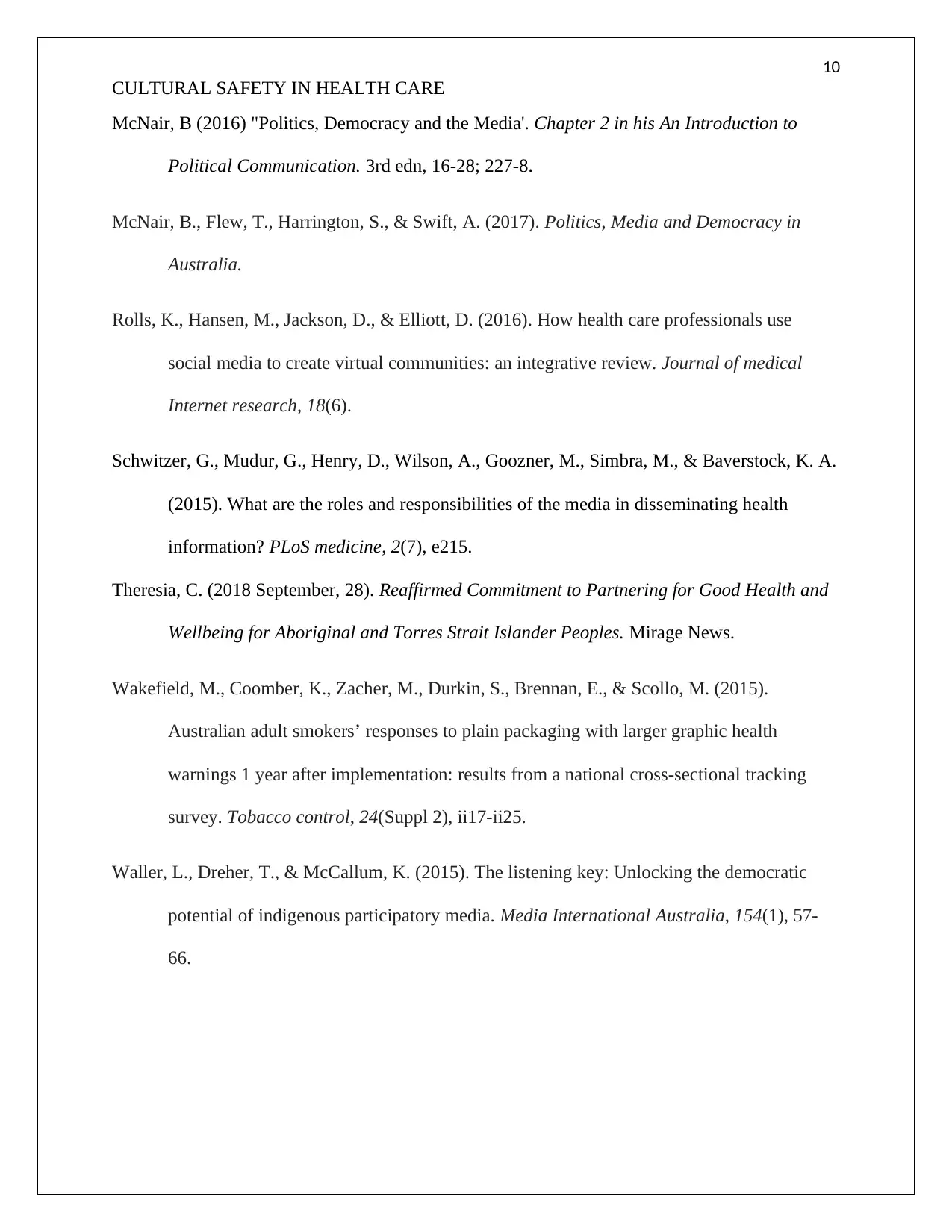
10
CULTURAL SAFETY IN HEALTH CARE
McNair, B (2016) "Politics, Democracy and the Media'. Chapter 2 in his An Introduction to
Political Communication. 3rd edn, 16-28; 227-8.
McNair, B., Flew, T., Harrington, S., & Swift, A. (2017). Politics, Media and Democracy in
Australia.
Rolls, K., Hansen, M., Jackson, D., & Elliott, D. (2016). How health care professionals use
social media to create virtual communities: an integrative review. Journal of medical
Internet research, 18(6).
Schwitzer, G., Mudur, G., Henry, D., Wilson, A., Goozner, M., Simbra, M., & Baverstock, K. A.
(2015). What are the roles and responsibilities of the media in disseminating health
information? PLoS medicine, 2(7), e215.
Theresia, C. (2018 September, 28). Reaffirmed Commitment to Partnering for Good Health and
Wellbeing for Aboriginal and Torres Strait Islander Peoples. Mirage News.
Wakefield, M., Coomber, K., Zacher, M., Durkin, S., Brennan, E., & Scollo, M. (2015).
Australian adult smokers’ responses to plain packaging with larger graphic health
warnings 1 year after implementation: results from a national cross-sectional tracking
survey. Tobacco control, 24(Suppl 2), ii17-ii25.
Waller, L., Dreher, T., & McCallum, K. (2015). The listening key: Unlocking the democratic
potential of indigenous participatory media. Media International Australia, 154(1), 57-
66.
CULTURAL SAFETY IN HEALTH CARE
McNair, B (2016) "Politics, Democracy and the Media'. Chapter 2 in his An Introduction to
Political Communication. 3rd edn, 16-28; 227-8.
McNair, B., Flew, T., Harrington, S., & Swift, A. (2017). Politics, Media and Democracy in
Australia.
Rolls, K., Hansen, M., Jackson, D., & Elliott, D. (2016). How health care professionals use
social media to create virtual communities: an integrative review. Journal of medical
Internet research, 18(6).
Schwitzer, G., Mudur, G., Henry, D., Wilson, A., Goozner, M., Simbra, M., & Baverstock, K. A.
(2015). What are the roles and responsibilities of the media in disseminating health
information? PLoS medicine, 2(7), e215.
Theresia, C. (2018 September, 28). Reaffirmed Commitment to Partnering for Good Health and
Wellbeing for Aboriginal and Torres Strait Islander Peoples. Mirage News.
Wakefield, M., Coomber, K., Zacher, M., Durkin, S., Brennan, E., & Scollo, M. (2015).
Australian adult smokers’ responses to plain packaging with larger graphic health
warnings 1 year after implementation: results from a national cross-sectional tracking
survey. Tobacco control, 24(Suppl 2), ii17-ii25.
Waller, L., Dreher, T., & McCallum, K. (2015). The listening key: Unlocking the democratic
potential of indigenous participatory media. Media International Australia, 154(1), 57-
66.
1 out of 10
Related Documents
Your All-in-One AI-Powered Toolkit for Academic Success.
+13062052269
info@desklib.com
Available 24*7 on WhatsApp / Email
![[object Object]](/_next/static/media/star-bottom.7253800d.svg)
Unlock your academic potential
Copyright © 2020–2025 A2Z Services. All Rights Reserved. Developed and managed by ZUCOL.





